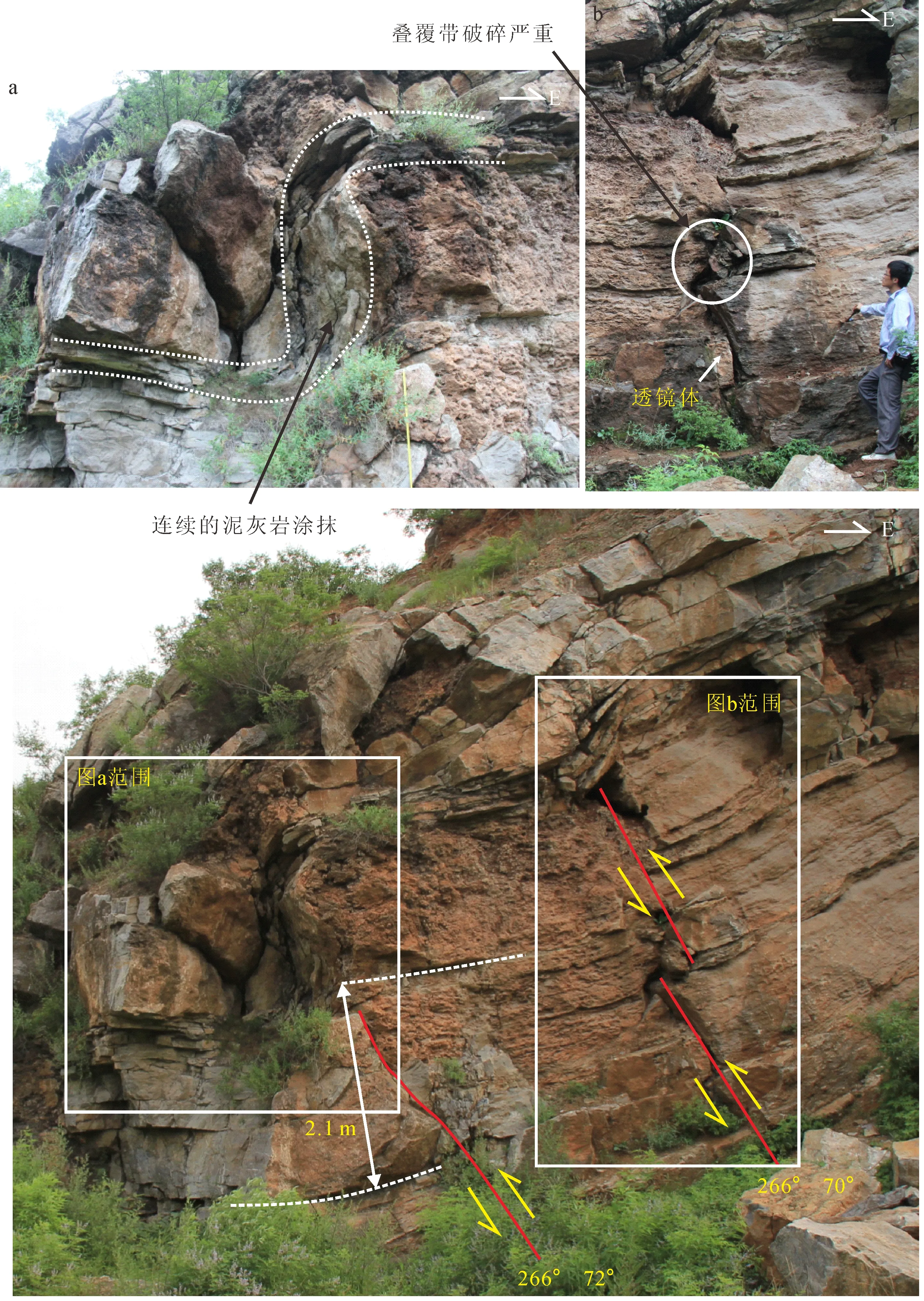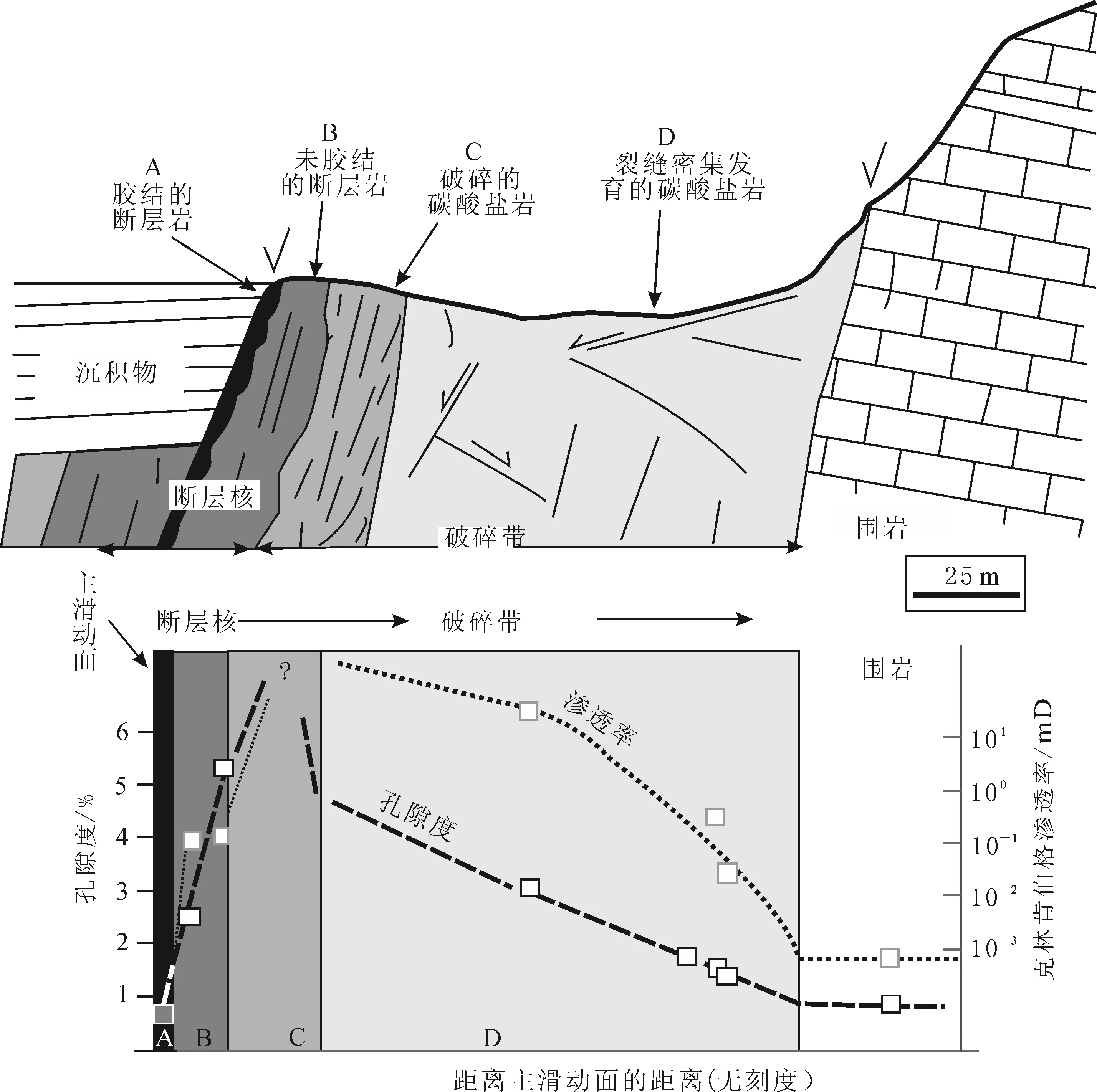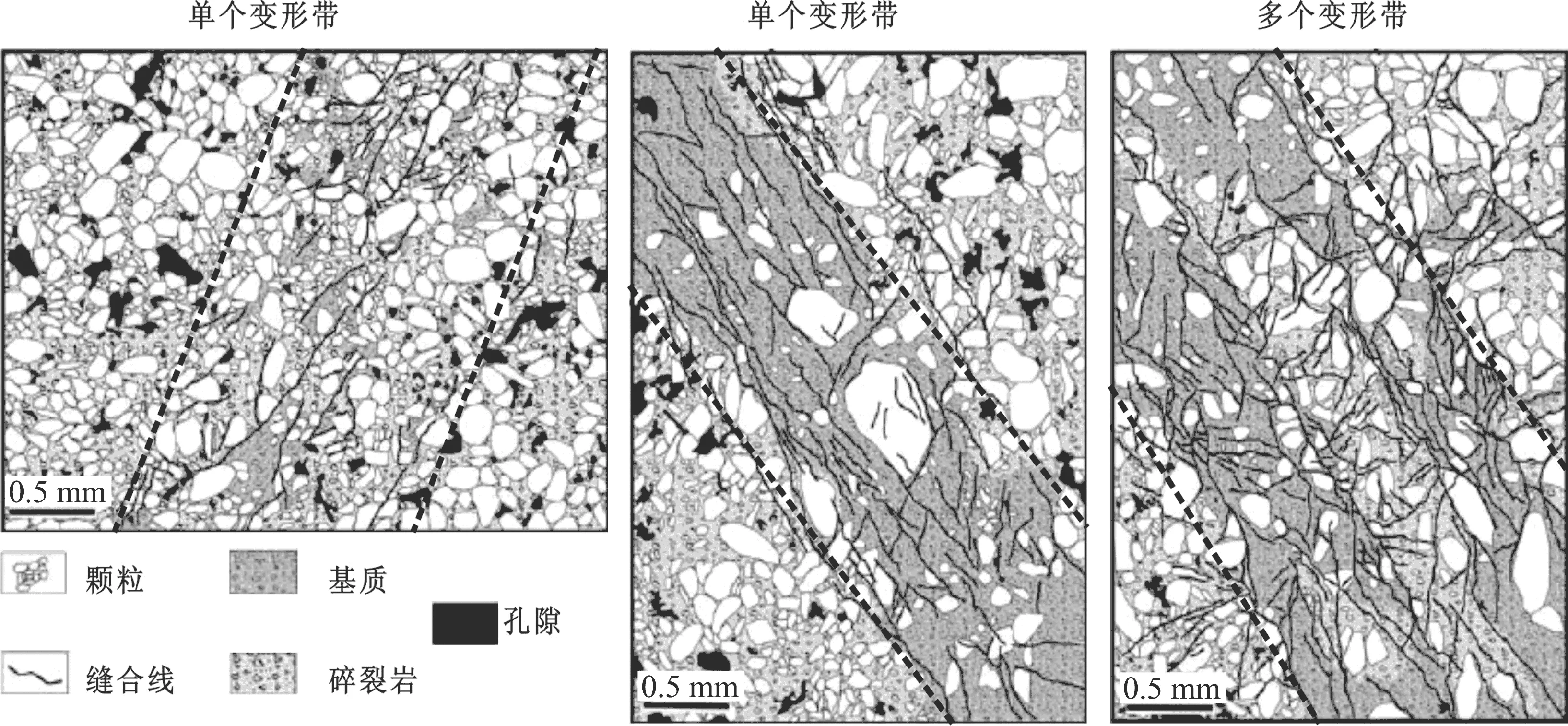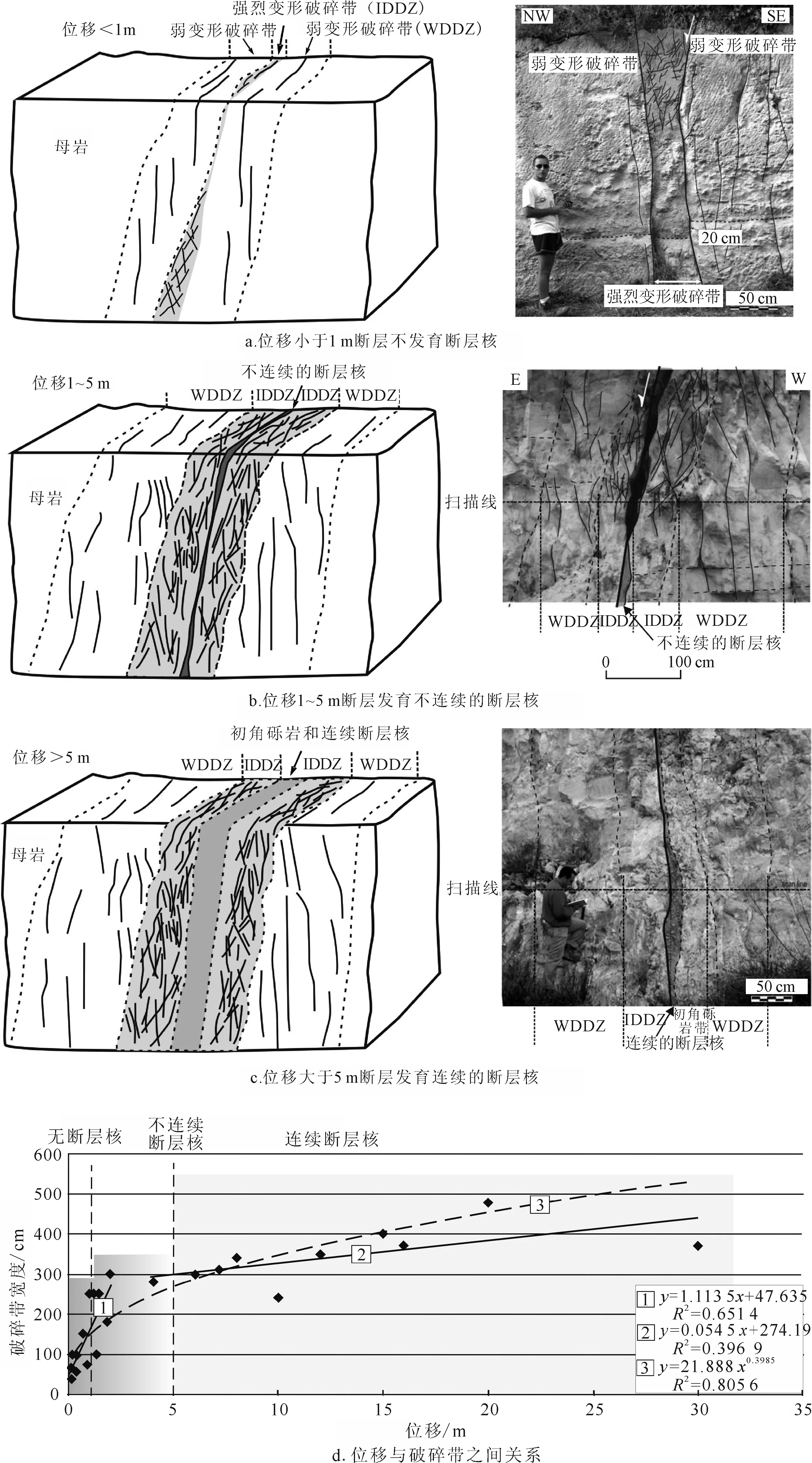碳酸盐岩内断裂带结构及其与油气成藏
2014-07-05付晓飞孟令东
郄 莹,付晓飞,孟令东,许 鹏
东北石油大学CNPC断裂控藏实验室/非常规油气成藏与开发省部共建国家重点实验室培育基地,黑龙江 大庆 163318
碳酸盐岩内断裂带结构及其与油气成藏
郄 莹,付晓飞,孟令东,许 鹏
东北石油大学CNPC断裂控藏实验室/非常规油气成藏与开发省部共建国家重点实验室培育基地,黑龙江 大庆 163318
以野外观察描述为手段,系统研究了碳酸盐岩断裂变形机制的影响因素及断裂带结构演化过程,剖析了碳酸盐岩地层中断裂带结构与流体运移的关系。研究表明,影响碳酸盐岩内断裂变形机制的因素包括岩性、孔隙度、变形深度、温度、胶结作用、先存裂缝等,控制断裂带结构形成的因素包括滑动位移和破裂模式等。低孔隙度碳酸盐岩以裂缝发育为主,高孔隙度碳酸盐岩变形早期产生变形带,带内裂缝联接逐渐发育成断层带。随着埋藏深度的增加,断裂带结构不同:埋藏深度小于3 km,断层核主要发育无内聚力的断层角砾岩和断层泥;埋藏深度大于3 km,断层核普遍发育有内聚力的断层角砾岩和碎裂岩,破碎带发育多种成因的裂缝。随着位移的增加,破裂模式从早期的破裂作用变为后期的碎裂作用,最终形成碎裂流。断裂带演化是一个四维过程,断层核和破碎带发育情况直接影响断层对油气的运移和封闭的作用。断裂变形机制、断裂带内部结构以及与流体运移关系的研究,都可为封闭性提供重要的理论依据。
碳酸盐岩;断裂带结构;物性特征;控制流体成藏
0 引言
碳酸盐岩油气藏是世界油气重要的勘探领域。美国《油气杂志》于2009年12月发布世界年度储量调查报告显示,在全世界226个可采储量超过7 000×104t的大油气田中有116个是碳酸盐岩油气藏,占统计总数的44%,其可采储量占61%。根据新一轮全国油气资源评价结果,我国近300×104km2古生界海相碳酸盐岩石油、天然气资源分别约为135×108t和22.4×1012m3,分别约占我国石油、天然气总资源量的13.0%和47.6%,其中探明储量13.4×108t和1.42×1012m3,资源探明率分别为10.0%和6.3%。上述实际资料和统计数据充分说明了我国古生界海相碳酸盐岩油气资源潜力巨大;同时也说明了我国海相碳酸盐岩油气的探明率较低,尚不足总体探明率的一半。因此,加大海相碳酸盐岩油气研究和勘探力度,对实现油气资源的接替具有重要的意义。
断裂作为油气系统中重要因素之一,其变形机制及断裂带结构影响油气的富集情况。目前,国内外主要集中研究碎屑岩储层断裂变形机制及断裂带内部结构对油气运聚的影响,但对于碳酸盐岩的研究较为薄弱[1-2],国内也是鲜有报道[3-4]。因此,笔者以野外观察描述为手段,系统总结了断裂带内部结构的形成过程以及类型,明确了影响碳酸盐岩断裂变形的机制及断裂带结构形成的因素,剖析了碳酸盐岩内断裂带结构与流体运移的关系,从而为研究断裂对碳酸盐岩中油气富集的控制作用提供理论依据。
1 影响碳酸盐岩地层中断裂变形机制的重要因素

图1 秦皇岛柳江盆地秋子裕背斜西翼逆冲断层断裂带结构Fig.1 Thrust fault zone strcture at west edge of Qiuziyu anticline,Liujiang basin,Qinhuangdao
断裂变形机制及断裂带内部结构是断层封闭性和流体沿断裂运移规律研究的基础[5]。在含油气盆地范围内,多数碳酸盐岩在断裂过程中发生脆性变形,变形机制主要包括破裂作用[6]、碎裂作用[7-15]和碎裂流作用[16],少数岩性发生塑性变形,形成涂抹结构[17-22]。与其他非孔隙性岩石不同,由于碳酸盐岩矿物易于溶解和迁移,压溶作用明显[23-27]。影响断裂变形机制的因素既有内因(岩性、矿物成分、成岩阶段、孔隙度和渗透率),也有外因(温度、围压和变形深度)[28-39]。低-非孔隙性岩石主要发生脆性变形,形成渗透性较高的断裂带。但随着泥质含量增加,塑性变形越来越明显,泥岩、泥灰岩、膏泥岩和盐岩发生塑性变形,产生泥岩涂抹。如秦皇岛地区柳江盆地秋子裕背斜西翼两条逆冲断层(图1),背斜核部为张夏组鲕粒灰岩,顶部发育厚度为1 m的泥灰岩,逆冲断层伴随背斜拱起而形成,断裂在鲕粒灰岩层发生典型的脆性变形,形成初角砾岩带,而在泥灰岩层产生明显的泥岩涂抹。一般来说,按着孔隙度大小可将岩石分为3类:一是高孔隙度岩石,Fisher等认为孔隙度大于等于15%,为多种类型的砂岩;二是低孔隙度岩石,孔隙度小于15%,多为处于超固结成岩段的砾岩、砂岩和黏土岩[30];三是非孔隙性岩石,孔隙度普遍小于5%,包括碳酸盐岩、火山岩、变质岩、埋藏抬升后的硫酸盐岩和卤化物岩。高孔隙度碳酸盐岩(孔隙度≥15%)的主要变形机制与高孔隙度纯净砂岩相似,主要为碎裂作用和碎裂流作用,形成的微构造类型为变形带[31],如意大利亚平宁山脉Orfent碳酸盐岩地层中的变形带[32]。低孔隙度碳酸盐岩(孔隙度<15%)岩石变形,当埋藏深度小于3 km时,多为破裂作用,在破裂之初形成膨胀的裂缝,裂缝的联接将岩石切割破碎,形成无内聚力的断层角砾岩,如秦皇岛山亮甲山高角度正断层在抬升期形成,断裂带可见无内聚力断层角砾岩。当埋深超过3 km时,沿着裂缝发生摩擦滑动并伴随颗粒的滚动,逐渐形成碎裂流,形成无内聚力的断层角砾岩和碎裂岩[28],并出现大量的断层泥。希腊Corinth裂谷碳酸盐岩地层中Pirgaki断裂带结构发育有内聚力的碎裂岩和超碎裂岩,埋藏深度大于5 km[33](图2)。当地层埋藏固结成岩后抬升所发生的断裂变形,由于应力松弛和压力释放[28]导致张性裂缝大量发育,裂缝联接形成无内聚力的断层角砾岩。断裂生长过程中,流体-岩石的相互作用使裂隙胶结和封闭,可改变断裂带的强度和性质[34-38],增加岩石的内聚力。由于断层岩应变硬化作用,断层再次滑动并非追踪早期的断层面,新产生的断层面造成断裂带宽度逐渐增大。

图2 希腊Corinth海湾地区碳酸盐岩地层中Pirgaki断裂带结构[33]Fig.2 Structure of Pirgaki fault zone in carbonate layer, the Gulf of Corinth, Greece[33]
2 断裂带内部结构特征
断层不是一个单独的面,而是一个有一定宽度且包含不同特征断层岩的“带”,具有典型二分结构:断层核和破碎带[39-40]。断层核主要包括主滑动面和其周围发育的断层岩,断层岩主要类型包括断层角砾岩、碎裂岩、断层泥、灰泥涂抹和胶结的断层岩。破碎带靠近断层核,是由多组不同类型的裂缝、小断层和变形带组成的具有一定宽度的带,没有完全破坏围岩结构[41]。微构造数量随着断层核距离增加而逐渐减小,当密度与区域裂缝或变形带密度一致时,标志着破碎带结束[42](图3)。断裂带结构的复杂性取决于母岩的岩性、位移、先存构造、变形深度和应力场特征等[43-44]。依据断裂变形机制决定的断层、核中断层岩类型和破碎带微构造类型,可将碳酸盐岩内断裂带结构划分为3种类型:

图3 希腊Corinth海湾地区Aigion断层的裂缝发育情况Fig.3 Fracture development condition of Aigion fault in the Gulf of Corinth,Greece
一是母岩为高孔隙性碳酸盐岩,在固结成岩阶段形成断裂,断层核主要由碎裂岩、透镜体和滑动面构成,破碎带主要发育碎裂带。断层核渗透率比母岩低1~6个数量级,破碎带渗透率比母岩低1~3个数量级[31]。这种类型断裂带相对较少。
二是埋深小于3 km,或埋深超过3 km后抬升至近地表,或埋深超过3 km、但变形过程有高压流体参与,低孔隙性碳酸盐岩发生断裂变形,主要发生破裂作用,断层核包括无内聚力的断层角砾岩、断层泥、透镜体和滑动面,破碎带发育大量裂缝。断层核渗透率比母岩高1~3个数量级,破碎带渗透率比母岩高1~6个数量级[45](图4)。

mD(毫达西)为非法定计量单位,1 mD=10-3μm2。图4 Venere盆地边界断层断裂带结构及物性变化[45]Fig.4 Structure and physical properties of fault zone in boundary fault, Venere basin[45]
三是埋深大于3 km,低孔隙性碳酸盐岩内形成断裂,形成有内聚力断层角砾岩、碎裂岩、断层泥、构造透镜体和滑动面组成的断层核,破碎带发育大量的裂缝。断层核渗透率表现为很强的非均质性,有内聚力断层角砾岩和初碎裂岩比母岩高1~2个数量级,超碎裂岩渗透率比母岩低1~3个数量级,破碎带比母岩渗透率高1~6个数量级[46]。
3 断裂带内部结构演化模式
基于小规模断裂代表大规模断裂发育的早期阶段[29],因此研究不同规模断裂可以分析断裂带内部结构的形成演化过程。碳酸盐岩内断裂带内部结构演化模式大致分为3种类型。
3.1 碎裂带-断层核:“二元”结构断裂带
高孔隙性碳酸盐岩中的断裂源于碎裂带形成和发展[32,47-48],开始形成单个碎裂带,由于应变硬化作用[50],碎裂带强度高于围压,进一步变形会形成簇状变形带;当有流体参与或形成断层泥后会发生应变软化,进一步变形会形成滑动面并发育成断层(图5)。部分簇状变形带成为断裂破碎带的一部分,伴随着断裂活动,在破碎带中会新生一部分碎裂带。因此,断层核主要由碎裂带和滑动面组成,破碎带发育大量的碎裂带[49],随着距离断层核距离增加,碎裂带密度逐渐减小[31,50]。

图5 亚平宁山脉中部Majella山脉白垩纪高孔隙度碳酸盐岩变形带、簇状变形带[32]Fig.5 Deformation band, cluster deformation band in high porosity Cretaceous carbonate rock,Majella Moutain,middle part of Apeennines[32]
3.2 破碎带-断层核:“二元”结构断裂带
Micarelli等[51]研究发现(图6a-c):位移小于1 m的断层缺少断层核和碎裂岩,存在单独的滑动面和破碎带,且朝向断层面破碎带裂缝密度增加;当位移为1~5 m时,断层发育一个不连续的断层核,主要由破碎的角砾岩和碎裂岩组成;大位移的断层发育连续的断层核,断层核包含碎裂岩、透镜体和断层泥等。一旦断层核发育颗粒结构(如初角砾岩),它的进一步演化类似于碎屑岩变形带的发育[47,50,52],发生颗粒的转动与磨蚀,导致颗粒破碎。伴随断层核的形成,变形集中在断层核上,破碎带宽度不再明显增加(图6d)。在不同埋深的条件下,断层核部的组构随着位移的变化而变化。

图6 意大利地区碳酸盐岩内断裂演化模式[51]Fig.6 Evolution model of carbonate rock fault in Italian regions[51]
3.3 压溶缝-断层核:“二元”结构断裂带
在碳酸盐岩断层开始和发育的过程中,压溶缝占主导地位。美国Somerset三叠纪和侏罗纪石灰岩中的走滑断层,开始发育似雁行式的张性裂缝,通过压溶缝连接,沿着压溶缝发生剪切连接转动的岩脉,使岩脉和压溶缝连接部分发育。随着位移的增加,最后发育为贯通的断层[53]。Graham等研究了意大利Maiella山脉逆冲前缘白垩纪碳酸盐岩正断层开始和生长过程[45](图7),记录了位移从几毫米到50 m断层发育的详细结构并提出了理想的概念模型,通过压溶缝的生长、剪切、联接,最后形成一个成熟的断裂带。Agosta等[54]同样研究了中生代地台碳酸盐岩盆地边界正断层的断层演化过程,并对各阶段压溶缝与裂缝以及岩脉的相互关系、不同负荷条件下多时期的溶解作用和脆性裂缝作用进行了详细的描述。

图7 意大利Maiella山脉前陆冲断带白垩纪碳酸盐岩正断层的理想概念模型[45]Fig.7 Ideal conceptual model of normal fault in Cretaceous carbonate rock of foreland thrust belt, Maiella Mountain,Italy[45]
3.4 断裂带厚度随位移的变化规律
断裂带厚度变化分为2种情况:一是如果连续的变形导致应变集中,从而形成狭窄的活动滑动带,整个断裂带厚度保持恒定;二是大规模分叉断层产生和交叉断裂带作用,大规模凸起的切割,均导致母岩弱化并卷入断裂带中,使断裂带变宽。前人研究脆性断裂带厚度-位移关系后认为,由于断层岩石流变学和应变硬化与软化等作用的影响[55-56],厚度随着位移呈现线性增加,对不同规模的断层来说,厚度-位移关系相似[57-60]。Bastesen[60]对3个不同区域不同规模的103条碳酸盐岩断层核的厚度和位移的423个数据进行统计发现,厚度-位移具有明显的正相关关系,厚度随位移的增加而增大(图8)。数据偏离正常趋势的原因主要有:断裂带断层核和破碎带的界限模糊或露头限制导致测量错误;由于地层力学特征差异导致断层分段生长,从而使叠覆带和连接处宽度增大。

图8 Sinai,Svalbard 和Oman地区103条张性断层的断层核位移-厚度关系图[60]Fig.8 Displacement-thickness relationship of 103 normal faults in Sinai,Svalbard and Oman[60]
4 断裂带内部结构对油气运聚成藏的控制作用
不同的岩性组合具有不同的断裂带内部结构,物性特征差异也很大,在油气运聚成藏中的作用明显不同,主要体现在4个方面。
4.1 高孔隙性碳酸盐岩中断裂导致油气差异充注
高孔隙性碳酸盐岩内断裂具有碎裂岩填充的断层核和碎裂带发育的破碎带“二元”结构,断层核为碎裂岩,渗透率比母岩低1~6个数量级,破碎带中发育大量的碎裂带,渗透率比母岩低1~3个数量级,滑动面渗透率比母岩高1~3个数量级。滑动面为油气垂向运移通道(图9),沿着断裂垂向运移的油气向储层分流过程中受到碎裂带阻止,母岩孔隙度越大,破碎带中发育的碎裂带密度越大,渗透率越低,因此油气越不容易向高孔隙性储层中充注,往往孔隙度较低的储层中含油气性越好。

图9 高孔隙度碳酸盐岩断裂油气差异充注模式图Fig.9 Different hydrocarbon charging mode in high porsity carbonate rock fault
4.2 低-非孔隙性碳酸盐岩内断裂为油气优势运移通道
从碳酸盐岩断裂带内部结构的形成过程来看,油气垂向运移通道有3种类型:一是小位移断层,缺少断层核和碎裂岩带,破碎带较为发育,高密度裂缝连接增加了油气的垂向运移(图6a)。二是当变形发生在3 km以内特别是抬升期时,断层核主要发育无内聚力的断层角砾岩和断层泥,为高渗透性流体运移的通道;当变形发生在3 km以下时,断层核主要为碎裂岩和超碎裂岩(图2),碎裂岩的物性相对于母岩和超碎裂岩较好,为流体垂向运移的通道[61]。三是断裂变形过程中,一旦伴随高压流体注入,无论埋藏深度多大,均可形成无内聚力角砾岩,为油气垂向运移的通道。这三类断裂的破碎带均发育大量的裂缝,有效改善储层物性,为油气侧向运移提供了通道。
4.3 断层核渗透性决定侧向封闭能力及油气分布模式
断层核如果为低渗透性断层泥带或超碎裂岩带,或者无内聚力角砾岩被后期胶结物胶结,断裂带本身具有很强的封闭能力,能够封闭住一定的烃柱高度(图2)。如果断层核为高渗透性断层角砾岩和碎裂岩,断层岩不具有封闭能力,断层侧向封闭靠岩性对接[62],油气分布具有3个典型特征:一是油气紧邻区域性盖层分布;二是圈闭范围内最小断距决定烃柱高度和烃-水界面分布;三是油气主要分布在断裂的上升盘。
4.4 断裂带结构差异与“运移”和“封闭”的耦合关系
碳酸盐岩主要发生脆性变形,形成高渗透性断裂带,为油气运移提供优势运移通道;若顶部的区域性盖层发生塑性变形,可产生泥岩或泥灰岩涂抹,当泥灰岩在断裂带中保持连续,可起到顶部封闭的作用(图1)。多数学者[19-20,63-72]认为,泥岩涂抹的连续性受控于断距与泥岩厚度的比率(SSF值)大小,Faerseth认为:小规模断层(断距小于15 m),即亚地震断层,泥岩涂抹连续SSF值为1~50;SSF值达到20~50时泥岩涂抹保持连续,通常泥岩层厚度为几毫米至10 cm,断距为几分米至4 cm[18-29, 48,72-74]。对于规模较大的断层(断距大于15 m),泥岩涂抹保持连续性的临界值较小,一般为4~8[20,63-64,66-68,72]。高温高压物理模拟表明:有效正应力为30 MPa,当SSF大于4.9时,粉砂岩形成的涂抹失去连续性;有效应力提高到40 MPa,涂抹保持连续性的临界SSF值为6.6[69]。因此,相同泥岩随着埋深增加,泥岩涂抹越发育,且容易保持连续性。
5 结论与讨论
1)低孔隙度碳酸盐岩,在温度小于100 ℃、围压小于100 MPa条件下,主要以破裂作用、碎裂作用、碎裂流为主。断层岩包括无内聚力断层角砾岩、断层泥和碎裂岩。高孔隙度碳酸盐岩中可发育变形带。
2)当埋藏深度小于3 km时,断裂以破裂作用为主,主要形成无内聚力的断层角砾岩。当埋深超过3 km时,颗粒发生摩擦、滑动和滚动形成碎裂流,形成无内聚力的断层角砾岩和碎裂岩,并出现大量的断层泥。
3)碳酸盐岩断裂带物性结构特征为:高孔隙性碳酸盐岩,在固结成岩阶段形成断裂,断层核、破碎带渗透率均比母岩低。这种类型断裂带均可起到封闭作用。埋藏小于3 km,或埋深超过3 km后抬升至近地表,断层核、破碎带渗透率均比母岩高,断层核和破碎带均起到输导作用;埋藏大于3 km,断层核渗透率表现为很强的非均质性,有内聚力断层角砾岩、初碎裂岩和破碎带比母岩高,超碎裂岩渗透率比母岩低,断层核可起到封闭作用,破碎带起到垂向输导作用。
4)胶结的断层岩或为低渗透性断层泥带或超碎裂岩带,断裂带本身具有很强的封闭能力,能够封闭住一定的烃柱高度。如果断层核为高渗透性断层角砾岩和碎裂岩,断裂带本身不具备封闭能力,主要靠岩性对接进行封闭,油气紧邻区域性盖层分布,且主要分布在断裂的上升盘。
[1] Micarelli L,Moretti I,Daniel J M.Structural Properties of Rift-Related Normal Faults: The Case Study of the Gulf of Corinth, Greece[J]. Journal of Geodynamics,2003,36:275-303.
[2] Storti F,Billi A,Salvini F.Particle Size Distributions in Natural Carbonate Fault Rocks: Insights for Non-Self-Similar Cataclasis[J]. Earth and Planetary Science Letters, 2003, 206: 173-186.
[3] 屈泰来,邬光辉,刘加良,等. 碳酸盐岩断裂相分类特征:以新疆塔里木盆地柯坪露头为例[J].地球学报,2011,32(5):541-548. Qu Tailai, Wu Guanghui, Liu Jialiang,et al. The Classification and Characteristics of Carbonate Fault Facies: A Case Study of the Outcrop of Kalpin Area, Tarim Basin in Xinjiang[J].Geoscientica Sinica,2011,32(5):541-548.
[4] 邬光辉,陈志勇,屈泰来,等. 塔里木盆地走滑带碳酸盐岩断裂相特征及其与油气关系[J].地质学报,2012,86(2):219-227. Wu Guanghui,Chen Zhiyong,Qu Tailai,et al.Characteristics of the Strik-Slip Fault Facies in Ordovician Carbonate in the Tarim Basin, and Its Relations to Hydrocarbon[J].Geologica Sinica, 2012,86(2):219-227.
[5] 付晓飞,温海波,吕延防,等. 勘探早期断层封闭性快速评价方法及应用[J].吉林大学学报:地球科学版,2011,41(3):615-621. Fu Xiaofei, Wen Haibo, Lü Yanfang. Quick Evaluation Method and Its Application of Fault Seal During Early Exploration Period[J]. Journal of Jilin University:Earth Science Edition, 2011,41(3):615-621.
[6] Blenkinsop T G.Deformation Microstructures and Mechanisms in Minerals and Rocks[M]. Kluwer: Kluwer Academic Publisher, 2000:1-80.
[7] Aydin A, Johnson A M.Development of Faults as Zones of Deformation Bands and as Slip Surfaces in Sandstones[J]. Pure and Applied Geophysics,1978,116:931-942.
[8] Aydin A,Johnson A M.Analysis of Faulting in Porous Sandstones[J]. Journal of Structural Geology,1983,5:19-31.
[9] Beach A,Welborn A I,Brockbank P, et al. Reservoir Damage Around Faults:Outcrop Examples from the Suez Rift[J]. Petroleum Geoscience,1999,5:109-116.
[10] Du Bernard X,Labaume P,Darcel C.Cataclastic Slip Band Distribution in Normal Fault Damage Zones,Nubian Sandstones,Suez Rift[J].Journal of Geophy-sical Research,2002,107:21-41.
[11] Wibberley C A J,Petit J P,Rives T.Mechanics of Cataclastic ‘Deformation Band’ Faulting in High-Porosity Sandstone,Provence[J]. Science,2000,331:419-425.
[12] Underhill J R,Woodcock N H. Faulting Mechanisms in High-Porosity Sandstones:New Red Sandstone,Arran,Scotland[J].Geological Society London,1987,29:91-105.
[13] Beach A,Brown J L,Welbon A I. Characteristics of Fault Zones in Sandstones from NW England: Application to Fault Transmissibility[J].Geological Society,1997,124:315-324.
[14] Knott S D. Fault Seal Analysis in the North Sea[J]. AAPG,1993,77:778-792.
[15] Fisher Q J,Knipe R J. The Permeability of Faults Within Siliciclastic Petroleum Reservoir of the North Sea and Norwegian Continental Shelf[J]. Marine and Petroleum Geology,2001,18:1063-1081.
[16] Fossen. Structural geology[M]. Cambridge:Cambridge University Press,2010:119-185.
[17] Bouvier J D, Kaars-Sijpesteijn C H, Kluesner D F, et al.Three-Dimensional Seismic Interpretation and Fault Sealing Inwestigation,Nun River Field,Nigeria[J].AAPG,1989,73:1397-1414.
[18] Knipe R J.Faulting Processes and Fault Seal[C]//Larsen R M, Brekke H, Larsen B T. Structural and Tectonic Modelling and Its Application to Petroleum Geology. Amsterdam:Norwegian Petroleum Society,1992: 325-342.
[19] Lindsay N G,Murphy F C,Walsh J J,et al. Outcrop Studies of Shale Smear on Fault Surface[J].International Association of Sedimentologists Special Publication, 1993,15:113-123.
[20] Gibson R G. Fault-Zone Seals in Siliciclastic Strata of the Columbus Basin, Offshore Trinidad[J]. AAPG,1994,78:1372-1385.
[21] Lehner F K,Pilaar W F. The Emplacement of Clay Smears in Synsedimentary Normal Faults:Inferences from Field Observations near Frechen, Germany[C]//Moller-Pederson P,Koestler A G.Hydrocarbon Seals: Importance for Exploration and Production. Amsterdam: Norwegian Petroleum Society, 1997:15-38.
[22] Ottesen-Ellevset S,Knipe R J,Svavao. Fault Controlled Communication in the Sleipner Field,Norwegian North Sea: Detail, Quantitative Input for Reservoir Simulation and Well Planning[C]//Jones G, Fisher Q J, Knipe R J. Faulting, Fault Sealing and Fluid Flow in Hydrocarbon Reservoir.London:Geology Society,1998: 283-297.
[23] Wanless H R.Limestone Response to Stress:Pressure Solution and Dolomitization[J]. Sedim Petrol, 1979,49: 437-462.
[24] Bathurst R G C. Carbonate Sediments and Their Diagenesis[M]. New York: Sedimentol,1980.
[25] Scholle P A,Halley R B.Burial Diagenesis: Out of Sight,Out of Mind[J]. Mineral,1985, 36: 135-160.
[26] Ricken W. Diagenetic Bedding[M].Berlin: Earth Sciences, 1986.
[27] Moore C H. Carbonate Diagenesis and Porosity[M]. Amsterdam:Sedimental Science, 1989.
[28] Fossen H R A.Structural Geology[M].Cambridge:Cambridge University Press,2010:119-185.
[29] Fisher Q J,Knipe R J.The Permeability of Faults Within Siliciclastic Petroleum Reservoir of the North Sea and Norwegian Continental Shelf[J].Marine and Petroleum Geology,2001,18:1063-1081.
[30] Fisher Q J,Casey M,Harris S D.Fluild Flow Properties of Faults in Sandstone:The Importance of Temperature History[J].Geology, 2003, 31:965-968.
[31] Fossen H R A,Schultz Z K,Shiptonl. Deformation Bands in Sandstone: A Review[J].Journal of the Geological Society(London),2007,164:755-769.
[32] Tondi E, Antonellini M, Aydin A,et al. The Roles of Deformation Bands and Pressure Solution Seams in Fault Development in Carbonate Grainstones of the Majella Mountain, Italy[J]. Journal of Structural Geology,2006, 28: 376-391.
[33] Geraud Y, Diraison M, Orellana N.Fault Zone Geometry of a Mature Active Normal Fault: A Potential High Permeability Channel (Pirgaki fault, Corinth Rift,Greece)[J]. Tectonophysics, 2006, 426:61-76.
[34] Sibson R H.Structural Permeability of Fluid-Driven Fault-Fracture Meshes[J]. Journal of Structural Geology,1996,18(8):1031-1042.
[35] Tenthorey E, Cox S F, Toff H F. Evolution of Strength Recovery and Permeability During Fluid-Rock Reaction in Experimental Fault Zones[J]. Earth and Planetary Science Letters,2003,206:161-172.
[36] Tarasewicz J P T, Woodcock N H, Dickson J A D. Carbonate Dilation Breccias: Examples from the Damage Zone to the Dent Fault, Northwest England[J]. Geological Society of America Bulletin, 2005,117: 736-745.
[37] Collettini C, De Paola N, Holdsworth R E, et al .The Development and Behaviour of Low-Angle Normal Faults During Cenozoic Asymmetric Extension in the Northern Apennines, Italy[J]. Journal of Structural Geology, 2006,28:333-352.
[38] Woodcock N H, Dickson J A D, Tarasewicz J P T. Transient Permeability and Reseal Hardening in Fault Zones:Evidence from Dilation Breccia Textures[J]. Geological Society of London Special Publications,2007,270:43-53.
[39] Chester F M, Evans J P, Biegel R L. Internal Structure and Weakening Mechanisms of the San Andreas Faults[J]. Journal of Geophysical Research,1993,98:771-786.
[40] Caine J S,Evans J P,Forster C B.Fault Zone Architecture and Permeability Structure[J]. Geology,1996,24:1025-1028.
[41] Cowie P A, Scholz C H.Growth of Faults by Accumulation of Seismic Slip[J].Journal of Geophysical Research,1992,97:11085-11095.
[42] Micarelli L,Moretti I,Jaubert M,et al. Fracture Analysis in the South-Western Corinth Rift (Greece) and Implications on Fault Hydraulic Behavior[J].Tectonophysics, 2006,426:31-59.
[43] Sibson R H. Fault Rocks and Fault Mechanisms[J]. Journal of the Geological Society of London,1977,133:191-213.
[44] Butler C A,Holdsworth R E,Strachan R A. Evidence for Caledonian Sinistral Strike-Slip Motion and Associated Fault Zone Weakening,Outer Hebrides Fault Zone,Scotland[J]. Journal of the Geological Society,1995,152: 743-746.
[45] Graham B, Antonellini M, Aydin A. Formation and Growth of Normal Faults in Carbonates Within a Compressive Environment[J]. Geology,2003,31:11-14.
[46] Brosch F J,Kurz W. Fault Damage Zones Dominated by High-Angle Fractures Within Layer-Parallel Brittle Shear Zones: Examples from the Eastern Alps[C]//Wibberley C A J,Kurz W,Imber J R E,et al. The Internal Structure of Fault Zones.London: Geological Society, 2008:75-95.
[47] Aydin A,Johnson A M.Development of Faults as Zones of Deformation Bands and as Slip Surfaces in Sandstones[J].Pure and Applied Geophysics,1978,116:931-942.
[48] Hesthammer J,Fossen H.Uncertainties Associated with Fault Sealing Analysis[J].Petroleum Geo-science,2000,6:37-45.
[49] Pittman E D.Effect of Fault-Related Granulation on Porosity and Permeability of Quarts Sandstones,Simpson Group(Ordovician),Oklahoma[J].AAPG,1981,65:2381-2387.
[50] Aydin A,Johnson A M.Analysis of Faulting in Porous Sandstones[J].Journal of Structural Geology,1983,5:19-31.
[51] Micarelli L,Benedicto A C,Wibberley A J.Structural Evolution and Permeability of Normal Fault Zones in Highly Porous Carbonate Rocks[J].Journal of Structural Geology,2006,28:1214-1227.
[52] Antonellini M,Aydin A.Effect of Faulting on Fluid Flow in Porous Sandstones:Petrophysicial Properties[J].AAPG,1994,78:355-377.
[53] Peacock D C P, Fisher Q J, Willemse E J M.The Relationship Between Faults and Pressure Solution Seams in Carbonate Rock and the Implications for Fluid Flow[J].Geological Society, 1998,147:105-115.
[54] Agosta F,Aydin A. Architecture and Deformation Mechanism of a Basin-Bounding Normal Fault in Mesozoic Platform Carbonates, Central Italy[J].Journal of Structural Geology,2006,28:1445-1467.
[55] Scholz C H. Wear and Gouge Formation in Brittle Faulting[J]. Geology,1987,15: 493-495.
[56] Hull J.Thicknesse Displacement Relationships for Deformation Zones[J]. Journal of Structural Geology,1988,10:431-435.
[57] Otsuki K. On the Relationship Between the Width of Shear Zone and the Displacement Along Fault[J]. Journal of the Geological Society of Japan,1978,84:661-669.
[58] Robertson E C. Relationship of Fault Displacement to Gouge and Breccias Thickness[J]. Mining Enginee-ring,1983,35:1426-1432.
[59] Walsh J,Watterson J,Heath A E,et al. Representation and Scaling of Faults in Fluid Flow Models[J]. Petroleum Geoscience,1998,4:241-251.
[60] Bastesen E,Braathen A.Extensional Fault Cores in Micritic Carbonate:Case Studies from the Gulf of Corinth, Greece[J]. Journal of Structural Geology,2009,31:403-420.
[61] Micarelli L,Benedicto A,Wibberley C A J. Structural Evolution and Permeability of Normal Fault Zones in Highly Porous Carbonate Rocks[J]. Journal of Structural Geology,2006,28:1214-1227.
[62] 付晓飞,潘国强,贺向阳,等.大庆长垣南部黑帝庙油层浅层生物气断层侧向封闭性研究[J].石油学报,2009,30(5):678-684. Fu Xiaofei, Pan Guoqiang, He Xiangyang, et al. Lateral Sealing of Faults for Shallow Biogas in Heidimiao Formation of the Southern Daqing Placanticline[J]. Acta Petrolei Sinica, 2009,30(5):678-684.
[63] Yielding G,Freeman B,Needham T.Quantitative Fault Seal Prediction[J].AAPG Bulletin,1997,81(6):897-917.
[64] Younes A I,Aydin A. Comparison of Fault Sealing by Single and Multiple Layers of Shale:Outcrop Examples from the Gulf of Suez,Egypt[J]AAPG Annual Meeting Program,2001,10:222.
[65] Sperrevik S, Faerseth R B, Gabrielsen R H. Experiments on Clay Smear Formation Along Faults[J]. Petroleum Geoscience, 2000, 6:113-123.
[66] Yielding G. Shale Gouge Ratio: Calibration by Geohistory[C]//Koestler A G, Hunsdale R.Hydrocarbon Seal Quantification. Amsterdam: Norwegian Petroleum Society,2002:1-15.
[67] Doughty P T. Clay Smear Seals and Fault Sealing Potential of an Exhumed Growth Fault[J].AAPG,2003,87(3):427-444.
[68] Kim J W,Berg R R,Watkins J S,et al. Trapping Capacity of Faults in the Eocene Yegua Formation, East Sour Lake Field, Southeast Texas[J].AAPG,2003,87(3):415-425.
[69] Takahashi M.Permeability Change During Experimental Fault Smearing[J].Journal of Geophysical Research,2002,108(B5):1-15.
[70] Sorkhabi R,Tsuji Y. The Place of Faults in Petro-leum Traps, Faults, Fluid Flow, and Petroleum Traps[J]. AAPG,2005,85(1):1-31.
[71] Eichhubl P,D’Onfro P S,Aydin A,et al. Structure,Petrophysics,and Diagenesis of Shale Entrained Along a Normal Fault at Black Diamond Mines,California-Implicationsfor Fault Seal[J]. AAPG,2005,89(9):1113-1137.
[72] Faerseth R B. Shale Smear Along Large Faults: Continuity of Smear and the Fault Seal Capacity[J]. Journal of the Geological Society, 2006, 163:741-751.
[73] Speksnijder A. The Structural Configuration of Cormorant Block IV in Context of the Northern Viking Graben Structural Framework[J]. Geologie en Mijnbouw,1987,65:357-379.
[74] Gibson R G. Physical Character and Fluid-Flow Properties of Sandstone-Derived Fault Zones[J]. Geological Society, 1998,127:83-97.
Fault Zone Structure and Hydrocarbon Accumulation in Carbonates
Qie Ying,Fu Xiaofei,Meng Lingdong,Xu Peng
CNPC Fault Controlling Reservoirs Laboratory, Northeast Petroleum University/Unconventional Hydrocarbon Accumulation and Development Provincial Department of State Key Laboratory of Constructing Cultivation Base,Daqing 163318,Heilongjiang,China
Based on the field observation and description, the factors relevant to the mechanism of fault deformation and the process of fault zone structure evolution in carbonate rock are systematically discussed, and the relationship between fault zone structure and fluid flow in the carbonate formation is analyzed. The research shows that the relevant factors to the mechanism of fault deformation in carbonate rock include lithology, porosity, deformation depth, temperature, cementation, pre-existing fractures and so on, and the factors controlling the formation of fault zone structure include sliding displacement and fracture mode. Low-porosity carbonate rock is characterized by fracture, while for high-porosity carbonate rock, deformation zone developed in the early time of deformation, fractures gradually connected and developed into fault zone. With burial depth increasing the structure of fracture zone is changing: when the burial depth is less than 3 km, the core of fault mainly develop into fault breccias and fault gouge without cohesion; when the burial depth is more than 3 km, the core of fault mainly develop into fault breccias and cataclasite with cohesion and fractures of various causes developed in the fracture zone. With the depth increasing, fracture mode changes from early fracturing into late cataclasis, eventually cataclastic flow. Fracture zone evolution is a four-dimensional process, the development of fault core and fracture zone, directly affects faults on hydrocarbon migration and seal. The research on the mechanism of fault deformation, the internal structure of fault zones and the fluid migration, can provide important theoretical basis for seal.
carbonates;fault zone structure; physical characteristics;control fluid accumulation
10.13278/j.cnki.jjuese.201403104.
2013-12-13
中国石油科技创新基金研究项目(2012D-5006-0107);教育部科学技术研究重点项目(212041)
郄莹(1987-),女,硕士,主要从事断层封闭性及流体运移方面的研究,Tel:0459-6504955,E-mail:qieying2009@126.com
付晓飞(1973-),男,教授,主要从事断裂变形机制、封闭性及流体运移方面的研究,Tel:0459-6503740, E-mail:fuxiaofei2008@sohu.com。
10.13278/j.cnki.jjuese.201403104
P618.130.2
A
郄莹,付晓飞,孟令东,等. 碳酸盐岩内断裂带结构及其与油气成藏.吉林大学学报:地球科学版,2014,44(3):749-761.
Qie Ying,Fu Xiaofei,Meng Lingdong,et al.Fault Zone Structure and Hydrocarbon Accumulation in Carbonates.Journal of Jilin University:Earth Science Edition,2014,44(3):749-761.doi:10.13278/j.cnki.jjuese.201403104.
